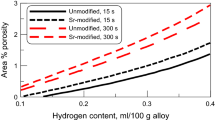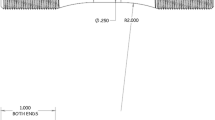Abstract
With the advent of linear elastic fracture mechanics, the detailed effects of processing and microstructure on toughness can be evaluated. The effect of microstructure on plane stress and plane strain fracture toughness is considered in detail together with strength, fatigue behavior and corrosion resistance. It is concluded that second phase particles in all size ranges can influence toughness. Increasing the size and amount of particles or decreasing precipitate coherency all lead to decreases in toughness. Grain structure is also shown to play a prominent role in determining plane stress fracture toughness ; at a given strength level, a fibrous grain structure and the prevention of recrystallization are desirable. The ability to influence fatigue crack propagation by control of processing is more remote though relatively little systematic work has been carried out in this field. Thermomechanical processing is considered to offer another possible route to achieving a desirable balance of toughness, strength and corrosion resistance.
Similar content being viewed by others
References
J. W. Evancho: “Development of an Al-Mg-Li Alloy”, Quarterly Report on Contract N62269-73-C-0219, May 1973.
I. N. Fridlyander, S. M. Ambartsumyan, N. V. Shiryaevn, and R. M. Gabidullin:Metalloved. Term. Obrab. Metal, 1968, vol. 3, pp. 50–52.
G.E. Thompson and B. Noble:J. Inst. Metals, 1973, vol. 101, pp. 111–15.
R. R. Cervay: Air Force Materials Laboratory Technical Report AFML-TR-72-173, 1972.
S. A. Levy, R. E. Zinkham, and G. E. Spangler: Paper No. 73-385, American Institute of Aeronautics and Astronautics, New York, 1973.
D. S. Thompson, O. R. Singleton, R. D. McGowen, and G. E. Spangler:Metal Progr., 1970, vol. 98, no. 3, pp. 78–83.
H. Y. Hunsicker:Aluminum, K. R. Van Horn, ed., vol. 1, pp. 106–62, ASM Metals Park, Ohio, 1967.
D. S. Thompson, S. A. Levy, G. E. Spangler, and D. K. Benson: Final Report on Air Force Materials Laboratory Contract F33615-72-C-1202, October 1973.
W. W. Binger, E. H. Hollingsworth, and D. 0. Sprowls:Aluminum, K. R Van Horn, ed., vol. 1, pp. 209–76, ASM, Metals Park, Ohio, 1967.
D. O. Sprowls and R. H. Brown:Proc. Conf. Fundamental Aspects Stress Corrosion Cracking, R. W. Staehle, Chief ed., pp. 466–506, NACE, Houston, Texas, 1967, published 1969.
E. A. Starke:J. Metals, 1970, [1], vol. 22, pp. 54–63.
H. P. van Leeuwen:Aluminium, 1972, vol. 48, pp. 719–22.
H. Antes, S. Lipson, and H. Rosenthal:Trans. TMS-AIME, 1967, vol. 239, pp. 1634–43.
S. N.Singh and M.C. Flemings:Trans. TMS-AIME, 1969, vol. 245, pp. 1811–19.
D. S. Thompson, B. S. Subramanya, and S. A. Levy:Met. Trans., 1971, vol. 2, pp. 1149–60.
R. J. Goode, R. W. Judy, and C. N. Freed: Naval Research Laboratory, Report 6871, 1969.
D. S. Thompson and S. A. Levy: “High Strength Aluminum Alloy Develop- ment”, Air Force Materials Laboratory Technical Report AFML-TR-70-171, August 1970.
R. E. Zinkham, H. Liebowitz, and D. L. Jones:Mechanical Behavior of Materials, vol. 1, pp. 370–93, The Society of Materials Science, Kyoto, Japan, 1972.
J. H. Mulherin and H. Rosenthal:Met. Trans., 1971, vol. 2, pp. 427–32.
P. Vigier:Rev. Alum., 1973, no. 417, pp. 279–88.
C. J. Peel, R. N. Wilson, and P. J. E. Forsyth:Metal Sci. J., 1972, vol. 6, pp. 102–06.
A. R. Rosenfield, C.W. Price, C.J. Martin, D. N. Williams, D. C. Drennen, D. S. Thompson, and R. E. Zinkham: “Research on the Synthesis of High Strength Aluminum Alloys”, Air Force Materials Laboratory Technical Report AFML-TR-74-129 Part 1, December 1974.
D. Broek: “The Effect of the Sheet Thickness on the Fracture of Cracked Sheet”, National Aerospace Laboratory, Amsterdam, NLR-TR-M2160, 1966.
G. T. Hahn and R. Simon: “Metallurgical Control of Fatigue Crack Growth in High Strength Aluminum Alloys,”, Air Force Materials Laboratory Technical Report AFML-TR-72-48, May 1972.
W. J. Plumbridge:J. Mater. Sci., 1972, vol. 7, pp. 939–62.
K. Erhardt, R. M. N. Pelloux, and N. J. Grant: Air Force Materials Laboratory Technical Report AFML-TR-69-85, 1969.
S. M. El-Soudani and R. M. Pelloux:Met. Trans., 1973, vol. 4, pp. 519–31.
P. J. E. Forsyth:The Physical Basis of Metal Fatigue, American Elsevier Publishing Company, New York, 1969.
B. J. Dunwoody, D. M. Moore, and A. T. Thomas:J. Imt. Metals, 1973, vol. 101. pp. 172–75.
I. Kirman:Met. Trans., 1971, vol. 2, p. 1761.
A. J. Sedricks, P. W. Slattery, and E. N. Pugh:ASM Trans. Quart., 1969, vol. 62, pp. 815–18.
A. J. Sedricks, P. W. Slattery, and E. N. Pugh:ASM Trans. Quart., 1969, vol. 2, p. 238.
G. Thomas and J. Nutting:J. Inst. Metals., 1959-60, vol. 88, p. 81.
P. C. Varley, M. K. B. Day, and A. Sendorek:J. Inst. Metals, 1957-58, vol. 86, p.337.
H. A. Holl:Corrosion, 1967, vol. 23, p. 173.
H. Gleiter and E. Hornbogen:Z. Metallk., 1967, vol. 58, pp. 157–63.
M. O. Speidel:Proc. Conf. Fundamental Aspects Stress Corrosion Cracking, R. W. Staehle, Chief ed., pp. 561–73, NACE, Houston, Texas, 1967, published 1969.
N. Ryum, B. Haeglund, and T. Lindtveit:Z. Metallk., 1967, vol. 58, pp. 28–31.
J. M. Dowling and J. W. Martin:Proc. 3rd Int. Conf. on Strength of Metals and Alloys, Cambridge, 1973, pp. 170–74, Inst. of Metals and the Iron and Steel Inst., London, 1973.
P. N. T. Unwin and G. C. Smith:J. Inst. Metals, 1969, vol. 97, pp. 299–310.
R. E. Zinkham, J. H. Dedrick, and J. H. Jackson:Aluminium, 1970, vol. 46. p. 624.
D. Broek, J. Schijve, and A. Nederveen: National Aeronautical and Astronauti- cal Research Institute, Amsterdam, The Netherlands, Report NLR-TR-M2134, 1965.
W. Schütz and Oberparleiter:Aluminium, 1972, vol. 48, pp. 734–38.
D. Broek and C. Q. Bowles:J. Inst. Metals, 1971, vol. 99, pp. 255–57.
W. Gruhl and H. Cordier:Aluminium, 1968, vol. 44, pp. 403–11.
D. O. Sprawls, M. B. Shumaker, J. D. Walsh, and J. W. Coursen: “Evaluation of Stress-Corrosion Cracking Susceptibility Using Fracture Mechanics Tech- niques”, Final Report Part I, NASA Contract No. NAS-8-21487, May 31, 1973.
R. F.Ashton:J. Metals, 1969 [9], vol. 21, pp. 35–38.
K. G. Kent:J. Aust. Inst. Metals, 1970, vol. 15, pp. 171–78.
T. Hiramatsu, M. Chikuda, Y. Miyagi, and K. Nagao:J. Jap. Inst. Light Metals, 1972, vol. 22, pp. 702–09.
A. Sendorek and A. W. Pearson:J. Inst. Metals, 1971, vol. 99, p. 33.
A. J. Cornish and M. K. B. Day:J. Inst. Metals, 1971, vol. 99, pp. 377–84.
P. A. Thackery and A. T. Thomas:J. Inst. Metals, 1971, vol. 99, pp. 114–17.
D. S. Thompson:Therm. Anal., Proc. Int. Conf. 2nd, Vol. 2, R. F. Schwenker and P. D. Gam, eds., Academic Press, New York, New York, 1968, published 1969.
A. J. Bryant:J. Inst. Metals, 1966, vol. 94, pp. 94–99.
J. E. Vruggink: “Quenching Rate Effects on Mechanical Properties of Heat Treatable Aluminum Alloys”, TMS Paper Selection No. A68-50, TMS-AIME, New York, 1968.
H. A. Holl:J. Inst. Metals, 1956-57, vol. 97, pp. 200–05.
M. Conserva and P. Fierini:Met. Trans., 1973. vol.4, pp. 857–62.
A. J. Bryant and A. T. Thomas:J. Inst. Metals, 1972, vol. 100, pp. 40–44.
D. Altenpohl and D. Uelze:Metals Mater., 1971, vol. 5, pp. 65–71.
S. N. Singh and M. C. Flemings:Trans. TMS-AIME, 1969, vol. 245, pp. 1803- 09.
D. S. Thompson and S. A. Levy: Second Quarterly Report on Air Force Materials Laboratory Contract F33615-69-C-1643, 1969.
A. J. Bryant and A. T. Thomas:J. Inst. Metals, 1972, vol. 100, pp. 40–44.
J. Waldman, H. Sulinski, and H. Markus: “New Processing Techniques for Aluminum Alloys”, Army Mater. Tech. Conf., Wentworth-by-the-Sea, N. H., October 1972.
A. J. McEvily, Jr., J. B. Clark, and A. P. Bond:Trans. ASM, 1967, vol. 60, pp.661–71.
M. Conserva, E. Di Russo, and F. Gatto:Alluminio, 1968, vol. 37, no. 9, pp. 441–45.
A. J. Jacobs: “Optimizing the Combination of Strength and Stress-Corrosion Resistance of 7075 Aluminum by Thermal-Mechanical Treatments”, Contract No. N00019-69-C-0339, March 1970.
F. Ostermann:Met. Trans., 1971, vol. 2, pp. 2897–902.
V. A. Pavlov, Yu. I. Filippov, and S. A. Frisen:Fiz. Metal. Metalloved., 1965, vol. 20, pp. 770–74.
D. S. Thompson, S. A. Levy, and D. K. Benson:Proc. 3rd Int. Conf. on Strength of Metals and Alloys, Cambridge, 1973, pp. 119–23, Inst. of Metals and the Iron and Steel Inst., London, 1973.
A. W. Sommer, N. E. Paton, and D. G. Folgner: “Effects of Thermomechanical Treatments on Aluminum Alloys”, Air Force Materials Laboratory Technical Report AFML-TR-72-5, February 1972.
E.Di Russo, M. Conserva, F. Gatto, and H. Markus:Met. Trans., 1973, vol. 4, p.1133.
W. H. Reimann and A. W. Brisbane:Eng. Fract. Mech., 1973, vol. 5, p. 67.
N. E. Paton and A. W. Sommer:Proc. 3rd Int. Conf. on Strength of Metals and Alloys, Cambridge, 1973, pp. 101–08, Inst. of Metals and the Iron and Steel Inst., London, 1973.
Author information
Authors and Affiliations
Additional information
This paper is based on an invited presentation made at a symposium on “Advances in the Physical Metallurgy of Aluminum Alloys” held at the Spring Meeting of TMS-IMD in Philadelphia, Pennsylvania, on May 29 to June 1, 1973. The symposium was co-sponsored by the Physical Metallurgy Committee and the Non-Ferrous Metals Committee of TMS-IMD.
Rights and permissions
About this article
Cite this article
Thompson, D.S. Metallurgical factors affecting high strength aluminum alloy production. Metall Trans A 6, 671–683 (1975). https://doi.org/10.1007/BF02672287
Issue Date:
DOI: https://doi.org/10.1007/BF02672287




